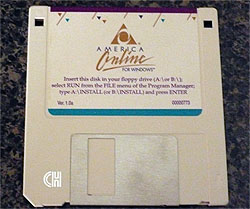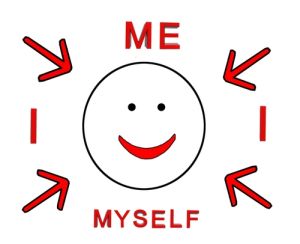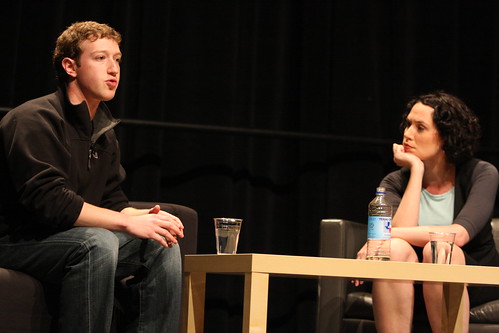 Many tech geeks will often say that their first forays into cyberspace began with a 300 baud modem and a BBS. I’m a little younger than that (finally, I can say that!), but I was an early adopter of social networks from when I first opened my 3.5″ floppy of Promenade (later to be called AOL) and signed up to use the service.
Many tech geeks will often say that their first forays into cyberspace began with a 300 baud modem and a BBS. I’m a little younger than that (finally, I can say that!), but I was an early adopter of social networks from when I first opened my 3.5″ floppy of Promenade (later to be called AOL) and signed up to use the service.
I used Prodigy, but I never was a fan of the randomly generated alphanumeric username and didn’t stick around. On the other hand, my first ever interaction on AOL was with someone who was separated from my social network by only one degree. I was 12 at the time, it was 1993, and AOL cost $5.95/hour (after a flat rate of $9.95 which included 5 hours of online usage).
One morning before school, I logged onto AOL and joined a chat room for the very first time. It was around 6:20am (and it was also 1993), so the rooms were relatively empty with the exception of two other chatty gentlemen. One was 50 (as a twelve year old, I actually remember saying “you’re old!” to him and receiving a shocked response), and the other didn’t live further than 20 minutes away from me. Ironically, he and I attended the same school (though he was double my age) and we even had the same teachers. At that point, I already knew I had a future of doing something online, though as a sixth-grader, I couldn’t quite put my finger on it. (Fortunately for me, while I never met that guy, I met other online friends in real life, as AOL was also safe at the time. Early adopters are typically normal people; the network hadn’t been infiltrated by people looking to exploit young children until the momentum grew.)
My first social “network” was also on AOL. I became a big fan of playing games (bingo especially) at a little hub on AOL called RabbitJack’s Casino, which was considered a unique community within the AOL borders with a close-knit group of people from all walks of life. By the time I was fifteen, I had encountered a more diverse crowd than most kids my age. I still even keep in touch with a few special individuals from those days.
I spent time on AOL as remote staff, growing my connections online (and some interestingly would later become colleagues) until I dropped AOL entirely to focus on my studies. That was almost a decade ago.
Fifteen years have passed, and while much has changed technologically, the concepts that animated web users back in the old days remain as relevant as ever. Social media was always social, just not with that funny name. Forums existed well before I was born, after all. They evolved into sites with graphical interfaces. Whereas everything used to cost money (my highest AOL bill was $267.48 in 1995), advertisers are now paying for programs so that we can use them and enjoy the applications without shelling out a dime, and web services providers are seeing the value of being free for users by monetizing their sites instead with ad revenue. At the same time, the concept of “free” is empowering individuals to become publishers, as any individual can now harness free software online to create his/her little on place on the web. Blogs are the new medium for a person to talk about areas in which the individual has exhibited some level of expertise or even to articulate thoughts on subject matters that interest nobody but a small group of people. The freedom is now in the hands of any consumer with an internet connection and computer.
Traditional media is being rejected as individuals are now often heard (and sometimes rather loudly) when they speak. Radio is being listened to online, and podcasts are popular among technological savvy folks. Whereas one needed an expensive VHS cassette recorder in 1993 to create a home video, even $40 cell phones (or digital cameras) can capture quality images and video that can be placed online for a much larger audience than ever before. It’s no surprise that everyone’s aiming for their fifteen minutes of fame (though they are possibly risking their futures because of that desire). Watching real television online, too, is becoming increasingly more mainstream.
Fifteen years ago, the Yellow Pages in our house was torn and tattered from frequent use. I was recently cleaning out a cabinet in my apartment and tossed out a 2005 Yellow Pages that was in pristine condition. Today, search engines answer the questions that phone books needed to solve a decade and a half ago. Today, Facebook or MySpace will help you locate lost family or reunite with old friends. Today, you can pull up a map online and print driving directions instead of phoning your desired destination for directions (and then writing each individual step on paper). Today’s printers are also faster and more reliable than the dot matrix printers of the nineties.
Today, you’re not viewed as a geek when you say that you spend a lot of your time online. In 1999, when I graduated high school, my last will and testament in my high school year book was “to have an online wedding.” (I didn’t.) Today, nearly all of my high school friends are online, and most of them maintain Facebook or MySpace accounts.
Computers are getting smaller, cheaper, and more efficient. Our family’s first computer (which wasn’t net-equipped) was an Apple IIgs which my father purchased in 1987. The first computer which I could actually call my own was that little IBM PS/1 PC I received at age 12. The cost: over $4k for a 386SX/25mhz with 170MB of hard drive space, 2MB RAM, a 2400 baud modem, and a 13″ monitor. I’m typing this blog post on a $750 Dell Inspiron 700m laptop (which I purchased nearly 3 years ago) which is lighter than the keyboard I used in 1993 and sports a high resolution despite its 12″ screen size. Beyond a little notebook computer, more and more people are starting to take advantage of mobile technologies, particularly within their cell phones, to create and produce content. Just a few weeks ago, I wrote a full blog post on my Palm Treo (though I don’t recommend it); the Palm Treo has a 2GB miniSD card in its slot, which is 12 times the size of that hard drive I was using in 1993.
Fifteen years ago, scanners were few and far between, but that’s what you needed in order to get your photographs to display on your desktop. Today, digital cameras can be had for as little as a few bucks. Fifteen years ago, optical media was virtually unheard of and the first consumer-friendly CD-RWs supported up to 650MB of media (for a hefty cost). Today, high-definition data means that one can store up to 50GB of data on a single optical disc of the same exact size. Zip drives are now obsolete; the latest trend is the pen drive (which makes for some great schwag).
I also have a confession to make. Fifteen years ago, h-t-t-p colon slash slash was foreign to me. (I still slap myself on the forehead when I recall tossing out a magazine from the Compuserve days that featured the best websites of that time.) I simply didn’t know what http:// meant, as the protocol sounded so … strange. For me, it was all about keywords and about navigating to content on AOL. (It was faster for me, anyway.)
Old technologies aren’t dying down; they’re just expanding. Twitter is the new chat room, but IRC still remains a popular choice behind services like Ustream and Y! Live. Email is still email (but doesn’t cost $0.25 to send like it did on Prodigy in the early nineties), but now it can be sent and accessed on mobile devices with the click of a button. For the younger generation, IM is replacing the phone, but for those who can’t break old habits easily, the phone is also moving to the computer through services such as Skype.
The technology landscape is changing, but old themes still remain relevant: the internet is a social place that will allow individuals to engage with others and establish new relationships on a common ground.
I just shared my own story about how I got here. When and how did you make it into the lovely World Wide Web? Feel free to add your story to the comments or in your own blog post.





Wow, you have seen the entire evolution! I am only now starting to check these social sites out, just Facebook and StumbleUpon so far.
I hope to join you guys on twitter soon, I see the trail you are blazing on StumbleUpon π
I got one for you. Before it was Promenade it was Q-Link. And I got you beat, I was Q-Link on a Commodore 64. Jesus, I just gave away my age and Geekiness in one swift stroke!
Actually, Jay, it was Q-Link for all computers besides IBM PS/1s. But particularly for IBM PS/1s, they called it “Promenade.” I have no idea why, but it made the experience a little more unique π
Fun article, Tamar. Thanx!
True *social* contact online for me began with listservs in 1993. Moved on to Classmates.com and Amazon book reviews. I had anonymous names and handles.
What has changed in the last three years for me, is how much more open I am with my online activity. The openness makes it more fun and meaningful.
Look forward to reading other stories here π
Great recent history review, thanks. Found your article through Barbara K’s Tweet.
Warmly,
Leif
http://www.SparkSocialMedia.com
Oh, and my story. I remember, I think about 1988, when I first saw someone type back to me from a BBS –oh my God was that exciting and a little freaky. It was like my computer had ‘come alive’ because the ‘life’ of some other person was now animating it. I think that was my hook point. And now we’re training AI through our social activities and games… (see gwap.com)
First computer with a modem was our Commodore 64, and a 300 baud modem (not acoustic, I’m not that old). I was online in 1985, possibly 1984. Somewhere around fourth grade.
First true internet access was 1995, as I went off to college in Silicon Valley (though I do remember using Yahoo earlier that year when the school I worked at had a connection).
Unfortunately Tamar I was a much later adapter of social networking — 2003.
But I was a very early adapter of computers and computing — 1967!
Your friend in Monsey,
Larry Brauner
Followed your tweet – great post. I tried to use AOL on a dial-up modem that didn’t function well. Can still hear that sing-song GOODbye! The world wide web was such a mystery…
I’m still not over that photo at the top – it looks like it was found in the Incan ruins…was it??
haha, no, I made my father take a photo of an AOL 1.0 disk that was laying around and he used the granite countertop as his backdrop, I guess π
: )
I really enjoyed this post (and always enjoy your sense of humor, haven’t commented until today).
I was 10 in 1993, and I remember the type of chat rooms available to myself and my older brother. It was definitely an exciting time of innocence lost and future career interests gained. But we didn’t know/definite it as such at the time.
Again, great, humanizing post.
Tell us how you needed an acoustic coupler rig to dial into BBSes and i’ll be really impressed!
This article was most articulate, and thought provoking. To remember every detail, every year, purchase prices and all is quite intriguing. I am so proud of you and your efforts to convey your observations, evaluations, and your perceptions to others. I commend you always, Tamar, for all of your contributions of knowledge you share with others.
Love, Mom
I’m one of the older one, Tamar. I started on Compuserve CB Simulator in 1981. ;o)
Thanks for the great column!
@ mommy: that was the cutest damn thing I’ve ever seen on this site.
Good for you guys : )
Now I feel old. Where is my walker?
I was surfing BBS way before the internet was known outside of geek circles. I used the computers at college at the time. When I finally got a computer it was a 386SX/33Mhz with 4MB RAM and a 180MB hard drive. I paid $1800.00 for it and got a 2400 modem with it. The case was a full tower and without anything in it weighed around 50lbs since it was steel. That was in 1992.
And that AOL disk is an eye soar. I was on AOL for a very very short time. Hated it because they wanted you only to stay on their site. They also didn’t like me being connected the entire weekend either. Lets just say I downloaded a lot back then. π I got so many AOL disks that I would find new uses for them. Coasters, frisbees, chew toys for the dog, or I would find a new way to destroy them each time.
I suppose this is why I get looked at funny when I mentioned words like; Telnet, Gopher, Archie, BBS, or USENET. Most people now don’t realize that the entire internet isn’t made up of just http://www…
I like this post but I really feel old now. Where are my happy pills and walker?
Sara
great post, but the title is a bit misleading. online social interactions are quite a bit older than than 15 years. remember usenet? alt.binary.*? that dates back to 1979. so wouldn’t that be 29 years? correct me if im wrong.
Online social interactions existed way before, and I even was on BBSes (but in the late nineties). The fifteen years refers to my personal journey.
@avi: she didn’t claim it was a “history” of social interactions online, but rather, her take on it.
re-read the first line! π
I like you, Andrew π
π
Likewise! Like I said, long-time reader, first-time commenter (here, at least). And, obviously, big-time fan!
Keep up the awesome work!
i didn’t say the post was misleading, but rather the title. Perhaps a better one would be “MY Fifteen Years of Online Social Interactions”?
Nice write-up! I did a post like this a while back. I couldn’t remember everything so descriptive like you did. π
Wow. Thanks for the nostalgia… My first toying around with interconnected-ness was on a little appletalk network in the mid-eighties. My first computers were Apple ][+ and C-64… My dad was in telecommunications so we had access to all sorts of compu-goodness, but then through the mid-eighties to mid-nineties the only computers we had were outdated or broke. So, for about 7 years (the Dark Years) we didn’t have a computer at all.
I remember friends’ parents on Prodigy and Compuserve. My re-entry in 1994 was on AO-Hell on a 9600 and a PowerMac 7200. Fell in love all over again, picked up a book on HTML 3.2, and been working in teh interwebs ever since.
Now, the mobile Web is here. I found you though BrightKite. You’re apparently somewhere around me. π
Good site, Subscribed!
I’m personally delighted by the transformation, although I find it fatiguing to keep up with the sheer speed of the acceleration. There aren’t enough hours in the day.
Great article. Thanks for taking me back… way back. Fun stuff, and I remember it all. I even have an old AOL disk like in the photo, and I still have my first laptop, a Compaq Portable 286. Thing weighs a ton. It wasn’t very portable. π
Great post! I’ve been saying this all along. Our behaviors aren’t changing, it’s the channel that is evolving, and we are mutually adaptive.
AOL had it all. Now it’s scattered. Any bets on where this going one year out?
Wow that brought back a lot of memories. I miss the early days of AOL chat rooms … I made a lot of friends and got a lot of dates in real life that way.
This Post is fantastic. My office mates and I were just talking about AOL “back in the day” and chatting with friends online. This just put the icing on the cake for our afternoon!
Whoa… blast from the past. Definitely remember that good ‘ol AOL disk, and being excited that I could finally get on to AOL from Canada. Also remember my father being more than unpleased with me for racking up those hourly charges.
I wonder if the AOL/Bebo deal will breathe some life back into it? Meh. Probably not.
I love how “social media” is a big buzzword now, but like you say, there has been social interaction online for a looong time! I date my development of online communities back to 95, when I started building and mentoring others at geocities.com. The notion of community was big there, you picked a “neighbourhood” and received a URL that read like a street address. A map showed your street and which houses were occupied or vacant.
I then mined links for dmoz – the Open Directory Project, which was a bit of a folksonomy because volunteer editors like myself could add or edit categories as we saw fit (although generally a single editor would be in charge of a particular domain).
I’ve been on livejournal, wow, since 98 or 99?
I then worked on a site geared towards at-risk youth, which encouraged community through volunteer authors, as well as bulletin boards and chat rooms.
That was all in the last millennium. While the tools to leverage social media are much more available to Everyman, that’s not to say the notion of communicating online wasn’t there!
Ah, you were one of the n00bs during the Eternal September. As the wikipedia article suggests, there are still people waiting for October 1. Hope springs eternal, I guess.
Other than that, I loved your article.
Dang mark-up…
hi tamara,
thanks for your aggregation. sometimes i think about my beginnings with the internet in 1996. we had a modem and the connection of the university and we dialed in but nothing was to see. hmm…cause we had no browser installed and didnt know, that we had to use one. well now we know π
and also in the beginnung my telefon invoice was really high about 160 /month. but i am still working with the possibility of the internet and enjoy of the opportunities of web 2.0.
maike
Wow, I really enjoyed reading how you came to be online…it’s really clear to me that the younger generations (I’m 36) have such a huge headstart on the rest of us. I didn’t really grow up with computers, so it’s been harder to make it all feel like second nature.
I refused to get an email address in college (early 90’s) because I was afraid. There, I said it. I didn’t understand what email was and I didn’t want to be a part of it.
Then, I married a computer genuis. He insisted that I learn how to use a computer, and got us a dial-up connection to the internet. I used it tentatively for a long time.
What really got me online, and this is going to sound strange, was the death of Princess Diana. I spent hours on forums and at news sites, reading people’s thoughts about her and posting my own. That sort of broke open the internet for me and took away my fear of being part of it all.
I’ve since learned never to say “never” when it comes to what I can or can’t do online – proud moments for me include learning how to make my own favicon and getting sitelinks for my store. See, a non-tech girl can get the hang of life online! It’s funny that I run a business that’s entirely web based (no storefront, and I sell PDFs). If I can do it, anyone can.
Hi Lori, thanks for sharing that awesome story. I might have to pass it onto my computerphobic relatives π
Yes, please do! When my parents were over for the 4th of July, we were talking about SEO and my dad said, “Lori, you are the only person I know who understands how the internet works”. It was an amazing compliment, and just shows how far I’ve come π
I enjoyed this post, thanks! I think I feel a bit old now. I was 16 in 1993. π
Mikebingo, you weren’t *that* much older. Only 4 years’ difference!
Hi Tamar!
As a German user of PS/1 2011 and 2121 I have not fully preloaded machines! Only US PS/1 have had that Prodigy or IBM Promenade Service!
As member of http://www.geos-infobase.de I am searching for that GEOS-based Promenade (disk or hd-copy), because it used GEOS’ CUA-GUI!
Can you or anybody here help me?
Greetings from Freiburg, Germany!
Manfred
Sorry, I don’t have that, Manfred. π